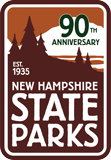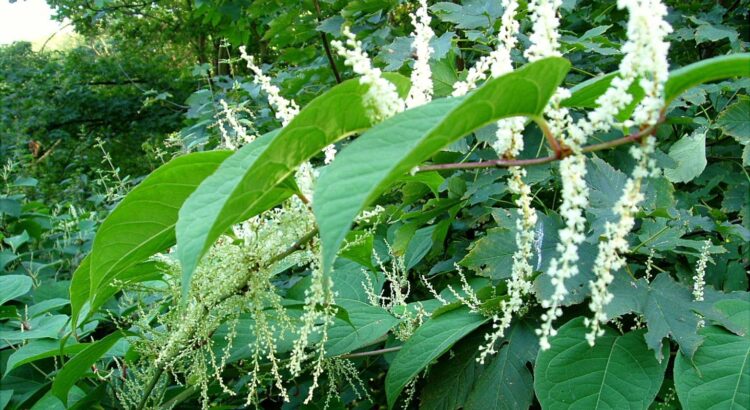Becca Leone, SCA Interpretive Ranger
Each year in late February, National Invasive Species Awareness Week (NISAW) is celebrated across the United States. The week began as an annual educational campaign coordinated by the North American Invasive Species Management Association. Initiated in 2014, the week-long campaign features numerous events with the goal of bringing attention to invasive species in each state. Even though February is still months away, we can still focus on invasive species by learning what they look like, how they spread, and how to report them.
Understanding how these species spread and negatively impact the environment can help slow their spread, aid in containment, or lead to eradication. Take your time looking through the plants and insects below to be able to identify these problem species and report them to the correct organization.
Giant Hogweed
Do Not Touch This Plant
Giant Hogweed (Heracleum mantegazzianum), a federally listed noxious weed, is of major concern. As of now, the USDA prohibits its possession with the intent to sell, import, purchase transport, introduce, or propagate. Giant hogweed is a biennial or perennial herb in the carrot family which can grow to 14 feet or more. Hollow, ridged stems grow 2-4 inches in diameter and have dark redish-purple blotches. The large compound leaves can grow up to 5 feet wide. White flower heads of this plant can grow up to 2 ½ feet in diameter. (NH Department of Agriculture, Markets & Food)
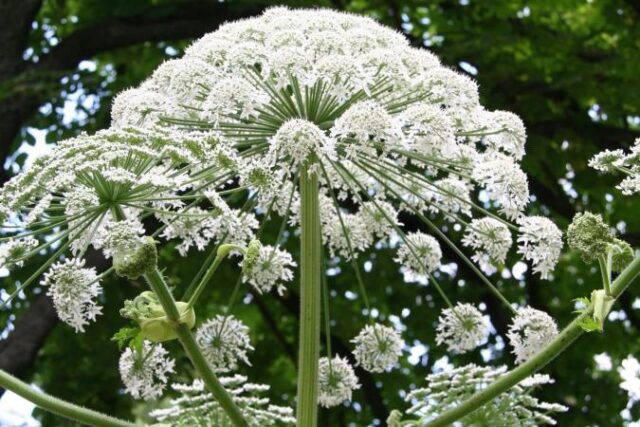
Ecological Impact
Giant Hogweed can create colonies of dense clusters as it grows due to the plant’s prolific seed production and rapid growth rate. As the plant grows, it forms colonies that can lead to crowding out slower-growing native plants. This creates a lack of sunlight for our native plants, killing them as they search for sunlight. As beneficial native plants are pushed out, the area’s use as a wildlife habitat is reduced. The displacement of native riparian plants also leads to future stream bank erosion.
What to do if you see Giant Hogweed:
- Identify: Use the pictures provided from NH.gov or UNH identification pages to try and make a positive identification. Similar looking plants are also shown on their page to aid in identification. Try to identify it without getting too close or touching it.
- Photograph: Photos of the plant are needed to confirm identification. Take high-resolution photos of the entire plant, stem, leaves, flowers, and seeds, making sure to keep a safe distance.
- Report:
- Email the UNH Cooperative Extension or report the find to EDDMapS
- Provide photos, and detailed directions to the plant infestation (GPS coordinates and street address are a plus) and estimate the number of plants found.
What to do if you come in contact with Giant Hogweed:
Giant Hogweed’s sap causes phytophotodermatitis (hypersensitivity to ultraviolet light) which can result in scars, blisters, and even blindness. If you come into contact with this plant, seek medical attention! Wash the affected area thoroughly with soap and water and keep the area away from sunlight for 48 hours. If you think you have Giant Hogweed on your property, do not touch it.
Japanese Knotweed
Japanese knotweed (Fallopia japonica) is a perennial herb that was originally introduced in the late 1800s from Eastern Asia as an ornamental plant. Related to buckwheat, Japanese knotweed, has the means to control soil erosion along streams, rivers, and other areas of water. The plant is identified by its bamboo-like stems which can grow from 3 to 15 feet in height. Looking closer at this plant will reveal it’s hollow stems and swollen leaf joints. Leaves can range from 4-6” long and 3-4” wide. Flowers, when in bloom, are white or pink and densely crowded on the stalks.
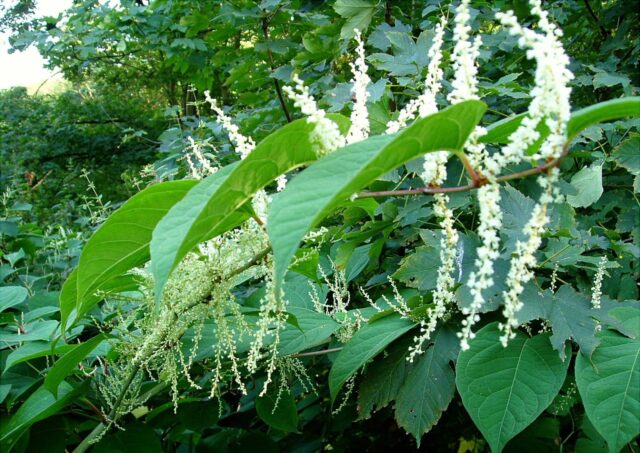
Ecological Impact
Japanese knotweed spreads rapidly, forming dense thickets that crowd and shade out native vegetation. These thickets affect the area they invade by reducing species diversity, altering natural ecosystems, and negatively impacting the wildlife habitats. Soil under knotweed thickets tends to have very little other growth due to the sun blocking ability the thickets have. Therefore, this bare soil is susceptible to erosion, posing a threat to riparian areas. Once established, populations of Japanese knotweed are extremely persistent and hard to eradicate. (New Hampshire Department of Agriculture, Markets & Food)
What to do if you see Japanese Knotweed:
- Prevent: One of the best ways to prevent Japanese Knotweed from colonzing an area is to ensure that disturbed habitats are rehabilitated with native vegetation. Plant natives wherever you can in spaces that are most susceptible to knotweed such as, disturbed areas and riparian buffers.
- Control: Young plants can be pulled by hand depending on soil conditions and root development. If all of the root system isn’t removed, re-sprouting can occur. Do not mow this plant because even small pieces left behind can sprout and spread, making the spread worse. Chemical controls for Japanese knotweed are utilized when the infestation effects a larger area. These include application of herbicides to freshly cut stems or to foliage. Before using chemicals to control any invasive plant, check with your local Cooperative Extension office to find out what chemicals are legal for use on knotweed in your area.
- Report:
- Take a picture of the entire plant and close-ups of the leaf, flower and/or seed.
- Note the location (intersecting roads, landmarks or GPS coordinates).
- Report the infestation to EDDMapS online or through the Outsmart Invasives app
Emerald Ash Borer
The Emerald Ash Borer (Agrilis planipennis), commonly called EAB, is an invasive wood-boring beetle. Native to Asia, it was likely introduced in the mid 1990s in ash wood used in shipping containers or wood pallets. EAB as a wood-boring insect targets North American ash tree species, feeding on them and eventually leading to their death. The beetle is small, only around ⅜ to ⅝ of an inch long when fully grown. It has four life stages: egg, larva, pupa, and adult. The adult beetle has a shiny emerald green elytra (protective hard wings) with a coppery red abdomen. When identifying whether an ash tree is infested, look for the “D” shaped exit holes in the bark that the adults leave behind. Adults are active and commonly seen from May-September but are most prevalent in June and July. (New Hampshire Agriculture, Markets & Food)
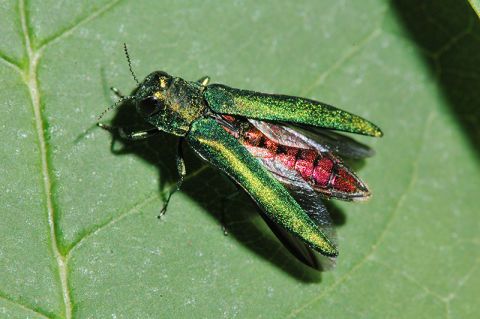
Ecological Impact
Ash species (white, green, and black) comprise almost 6% of all trees in NH State and is a widespread street tree in communities. With EAB killing our Ash, the most significant impact is to the communities now faced with removal of dead trees. Many of these dead trees are public safety hazards and liability problems for municipalities as they succumb to EAB. (New Hampshire Municipal Association)
What to do if you see EAB:
- Monitor: Monitor your ash trees and look for the signs and symptoms of EAB. This can include: increased woodpecker activity, s-shaped galleries under bark, D-shaped exit holes, and dying branches.
- Identify: Using the UNH Extension identifying EAB webpage, determine that the insect you have found is in fact EAB. The most common way to make sure is by identifying the damage they cause rather than seeing the beetle itself. If an Ash on your property has EAB, you have the option to remove the tree before it dies and falls.
- Report: Take photos of the insect and/or signs of damage. Then email your photos and location information to your local UNH Cooperative Extension.
Hemlock Woolly Adelgid
The Hemlock Woolly Adelgid (Adelges tsugae) is an aphid-like, invasive insect that poses a threat hemlock trees. Hemlock Woolly Adelgid (HWA) are very small, adults only reaching around 1.5mm in length. During the winter, you can identify the HWA by its white “woolly” masses of wax that the females leave behind. HWA has been expanding around New Hampshire since it’s introduction from Japan in 2000. With a complex life cycle, this insect is hard to track due to having two different tree hosts. HWA in New Hampshire however, remains in the same spot for the rest of their lives due to the lack of a suitable spruce for the second part of their life cycle.
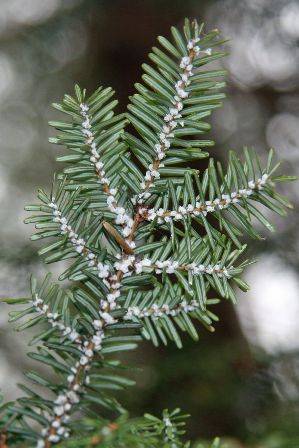
Ecological Impact
Hemlocks create a cool, damp, and shaded microclimate that supports terrestrial plant communities, maintains cool stream temperatures for fish and salamanders, and provides important winter habitat structure and food resources for wildlife. HWAs feeding severely damages the canopy of the hemlock tree by disrupting the flow of nutrients to its twigs and needles. Dieback of major limbs occurs within two years and progresses from the bottom of the tree upward. The infected tree’s health declines until mortality occurs within 4 to 10 years.
What to do if you see HWA:
- Identify: Detecting new infestations is critically important. You can identify HWA when the “woolly” white ovisacs are present on the needles. Winter is the optimal time to detect HWA as the ovisacs are easier to see on the needles.
- Control: Currently, the two approaches for managing HWA infestations are chemical insecticides and the use of natural predators as biological control. Unfortunately, the costs associated with application, environmental safety concerns about applying insecticides near water resources, and the tremendous reproductive potential of HWA make this approach less feasible on a broad scale in natural areas.
- Report: Take photos of the insect and/or damage and email the photos and location to UNH Cooperative Extension and report the find to EDDMapS.
How You Can Help:
With a push for knowledge of invasive species in our region, the hope is that reporting will become more commonplace. Practicing the “Burn it Where You Buy it” rule is another action to take to prevent the spread of these invasive species. Many invasive insects (including the ones talked about above) can spread through the moving of firewood. Instead of traveling with firewood, burn only local firewood or plan on buying it at your destination if you are traveling. Continue to monitor and scout for invasives whether you are going on a neighborhood walk or hiking through the peaks. Report what you find and you may just save a whole area from a future infestation.
Resources:
All photos are from New York Invasive Species Information
Cited:
New Hampshire Department of Agriculture, Market & Food Plant Industry Division
